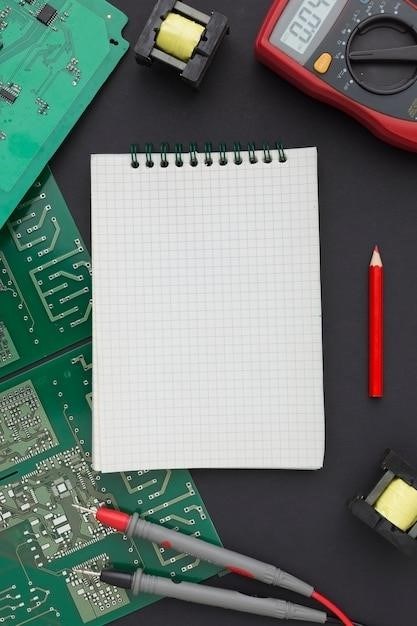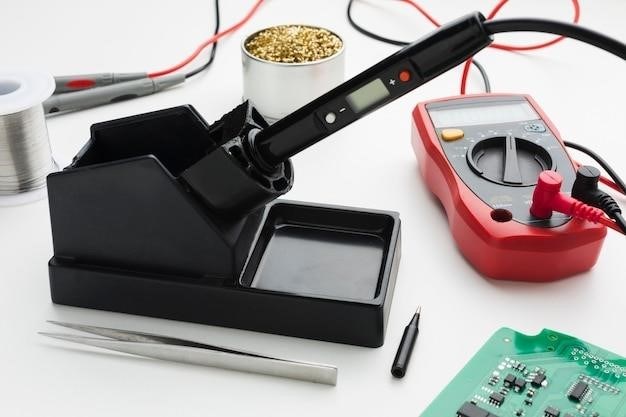Parts of a Digital Multimeter and their Functions
A digital multimeter, often referred to as a DMM, is a versatile and essential tool for anyone working with electronics․ It allows you to measure various electrical parameters, including voltage, current, and resistance, making it indispensable for troubleshooting, testing, and verifying electrical circuits․ This article will delve into the key components of a digital multimeter and explain their respective functions․
Introduction
The digital multimeter, a ubiquitous tool in the realm of electronics, has become an indispensable companion for professionals and hobbyists alike․ This versatile device, often referred to as a DMM, provides a comprehensive means of measuring various electrical parameters, including voltage, current, and resistance․ Its ability to measure both AC and DC signals makes it suitable for a wide range of applications, from basic circuit testing to more complex troubleshooting and diagnostics․ The core of a digital multimeter lies in its ability to convert analog signals into digital readings, providing accurate and precise measurements that are easily interpreted․ This article will explore the key components of a digital multimeter and the functions they perform, offering a detailed understanding of how this essential tool works․ By understanding the parts and their roles, individuals can effectively utilize the digital multimeter to gain insights into electrical circuits, identify issues, and ensure the proper functioning of electronic devices․
Key Components of a Digital Multimeter
A digital multimeter, in its essence, is a combination of several essential components, each contributing to its functionality and ability to measure various electrical parameters․ These components work in harmony to convert analog signals into digital readings, providing accurate and reliable measurements․ Understanding the roles of these key components is crucial for effectively utilizing the digital multimeter for testing, troubleshooting, and analyzing electrical circuits․ The primary components of a digital multimeter include the display or screen, the function selector or dial, the range selector, the test leads, the current measurement jack, and additional features that enhance its capabilities․ Each of these components plays a vital role in the overall operation of the multimeter, enabling it to measure a wide range of electrical quantities with accuracy and precision․
Display or Screen
The display or screen of a digital multimeter is the primary interface through which users interact with the device and interpret measurement results․ It acts as the visual window into the electrical parameters being measured, presenting the data in a clear and readable format․ The display typically consists of a digital readout, which displays the measured value numerically․ The display can be either LCD (Liquid Crystal Display) or LED (Light Emitting Diode), each with its own advantages․ LCD displays are known for their low power consumption, while LED displays offer higher brightness and visibility, particularly in low-light conditions․ The display often incorporates a variety of features to enhance readability and provide additional information․ These features can include⁚
- Polarity indication⁚ Displays a “+” or “-” sign to indicate the polarity of the measured voltage or current․
- Overload indication⁚ Displays a specific symbol or message to alert the user when the measurement range is exceeded․
- Auto-ranging⁚ Automatically selects the appropriate measurement range based on the input signal, simplifying the measurement process․
- Backlight⁚ Provides illumination for improved visibility in low-light environments․
- Data hold⁚ Freezes the displayed reading for easier observation and recording․
The display is a critical component of the digital multimeter, enabling users to accurately read and interpret measurement results, making it an integral part of the overall functionality of the device․
Function Selector or Dial
The function selector or dial is a crucial component of a digital multimeter, serving as the control center that allows users to choose the specific electrical parameter they wish to measure․ This rotary switch, often referred to as a “dial,” is typically located on the front panel of the DMM, making it easily accessible for selection․ The function selector is marked with various symbols and labels that represent the different measurement functions available․ These functions commonly include⁚
- DC voltage (VDC)⁚ Measures direct current voltage, which flows in one direction․
- AC voltage (VAC)⁚ Measures alternating current voltage, which changes direction periodically․
- DC current (ADC)⁚ Measures direct current, which flows in one direction․
- AC current (AAC)⁚ Measures alternating current, which changes direction periodically;
- Resistance (Ω)⁚ Measures the opposition to the flow of current․
- Continuity⁚ Tests the continuity of a circuit, indicating whether there is a complete path for current to flow․
- Diode test⁚ Measures the forward voltage drop of a diode, verifying its functionality․
- Capacitance (µF)⁚ Measures the ability of a capacitor to store an electrical charge․
- Frequency (Hz)⁚ Measures the rate at which an alternating current changes direction․
By rotating the function selector to the desired position, users can instruct the DMM to perform the specific measurement they require․ The function selector is a fundamental part of the digital multimeter, enabling it to perform a wide range of electrical measurements with precision․
Range Selector
The range selector, often found alongside the function selector on a digital multimeter, plays a vital role in ensuring accurate measurements by allowing users to adjust the measurement range for the chosen parameter․ This control, often a rotary switch or a series of buttons, determines the maximum value the DMM can measure for a specific function․ The range selector is typically marked with numerical values representing the different measurement ranges available․
For instance, when measuring DC voltage, the range selector might offer options like 200mV, 2V, 20V, 200V, and 1000V․ Selecting the appropriate range is crucial for obtaining accurate readings․ If the measured value exceeds the selected range, the DMM might display an overload symbol or an “OL” indicator, indicating that the reading is beyond its capacity․ Conversely, selecting a range that is too high can lead to lower accuracy and a less precise measurement․
The range selector is a key feature that enables the DMM to adapt to a wide range of electrical values․ By carefully choosing the appropriate range, users can ensure that the DMM operates within its capabilities, providing accurate and reliable measurements for diverse electrical applications․
Test Leads
Test leads, also known as probes, are the essential connection points between the digital multimeter and the circuit being measured․ They are typically composed of two insulated wires, one red and one black, terminating in pointed metal tips․ The red lead is usually connected to the positive (+) terminal of the DMM, while the black lead is connected to the negative (-) terminal․
These leads are used to make contact with various points in the circuit, allowing the DMM to measure voltage, current, or resistance․ The pointed tips are designed to easily pierce through insulation or make contact with conductive surfaces․ The insulation on the leads ensures user safety by preventing accidental electrical shocks․
When measuring voltage, the red lead is typically placed on the positive side of the component being measured, and the black lead is placed on the negative side․ When measuring current, the leads are connected in series with the circuit, effectively interrupting the current flow to allow the DMM to measure its intensity․ For resistance measurements, the leads are placed directly across the component being measured․
Current Measurement Jack
The current measurement jack, often labeled with an “A” or “mA” symbol, is a dedicated input on the digital multimeter designed specifically for measuring electrical current․ Unlike voltage and resistance measurements, which are performed with the test leads connected in parallel to the circuit, current measurements require the leads to be connected in series․ This means that the current flow must pass through the DMM in order to be measured․
To perform a current measurement, the circuit must be temporarily broken, and the test leads are connected in series with the break․ The red lead is typically connected to the positive side of the break, and the black lead is connected to the negative side․ The DMM then measures the current flowing through the circuit․ It’s important to note that current measurement can potentially overload the DMM if the circuit has a high current flow․ Therefore, it’s crucial to select the appropriate current range on the DMM before making the measurement․
The current measurement jack is often protected by a fuse to safeguard the DMM from damage due to excessive current․ The fuse is designed to blow and interrupt the circuit if the current exceeds a certain limit․ Always ensure that the fuse is properly installed and in good working order before performing current measurements․

Additional Features
Beyond the fundamental functions of measuring voltage, current, and resistance, modern digital multimeters often incorporate a variety of additional features that enhance their versatility and capabilities․ These features can significantly expand the range of applications for a DMM, making it a more comprehensive tool for troubleshooting and diagnostics․ Here are some commonly found additional features in digital multimeters⁚
Diode Test⁚ This function allows you to test the forward voltage drop of a diode and verify its functionality․ By placing the test leads across the diode, the DMM can measure the voltage drop when a small current is passed through it․ This helps identify whether the diode is working properly or if it’s faulty․
Continuity Test⁚ This feature helps determine if there is a continuous path for electricity to flow between two points․ The DMM emits an audible beep if a connection is detected, indicating that the circuit is complete․ This is useful for checking the integrity of wiring, switches, and other components․
Capacitance Measurement⁚ Some advanced DMMs offer the capability to measure capacitance, which is the ability of a capacitor to store an electrical charge․ This feature is particularly helpful in analyzing circuits that incorporate capacitors and can be used to determine the value of a capacitor or assess its health․
Frequency Measurement⁚ DMMs with frequency measurement capabilities can determine the frequency of an alternating current (AC) signal․ This is valuable for analyzing AC circuits and verifying the frequency of power supplies or oscillators․
Temperature Measurement⁚ Some DMMs include a built-in temperature sensor, enabling them to measure temperature․ This feature is useful for various applications, including monitoring the temperature of electronic components, checking the temperature of heat sinks, and conducting environmental temperature measurements․
In conclusion, a digital multimeter is an indispensable tool for anyone involved in electronics, whether you’re a professional technician, a hobbyist, or a student․ Its ability to measure various electrical parameters, including voltage, current, and resistance, provides valuable insights into the behavior of circuits․ Understanding the key components of a digital multimeter and their functions is essential for effectively utilizing this instrument․
The display, function selector, range selector, test leads, and current measurement jack play crucial roles in enabling the DMM to perform its measurements accurately․ Additionally, modern digital multimeters often incorporate a variety of additional features that enhance their versatility and capabilities․ These features, such as diode testing, continuity testing, capacitance measurement, frequency measurement, and temperature measurement, further expand the DMM’s range of applications․
By mastering the use of a digital multimeter, you gain the ability to troubleshoot electrical circuits, test components, and verify the performance of electronic devices․ This knowledge empowers you to diagnose problems, identify faulty components, and ensure the proper operation of electrical systems․ Whether you’re working on a simple circuit or a complex electronic device, a digital multimeter remains an essential tool for any electronics enthusiast or professional․
